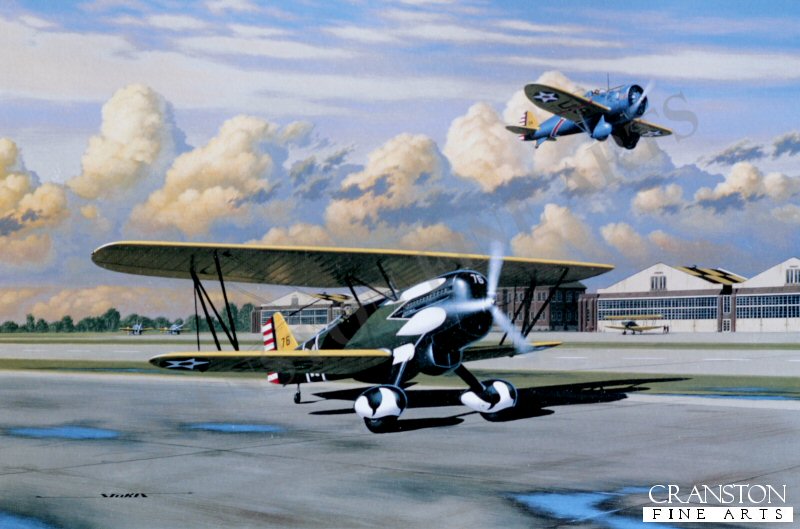- Sku:
- Vendor: Military Aviation Art Prints
Between Wars Classics by Stan Stokes.
During the between Wars years two aircraft manufacturers, Boeing and Curtiss, were the dominant suppliers of fighter aircraft for the United States armed forces. A series of Curtiss-manufactured hawk fighters was in service from the mid-1920s until just before WW II. The P-6E was delivered beginning in 1932 and was powered by a 675-HP Curtiss V-1570-23 Conqueror engine. This bi-plane fighter was highly maneuverable and capable of almost 200-MPH. It was armed with twin forward-firing 0.3 inch Browning machine-guns. In many respects it represented the pinnacle of American biplane fighter designs. In contrast the Boeing P-26 Peashooter was a very important transitional aircraft in the evolution of the fighter. It embodied the transition from the WW I vintage highly maneuverable biplanes to the sleek, very fast, all-metal, monoplane fighters of WW II. Surprising is the fact that the P-26 was the last fighter to be mass-produced by Boeing, the company founded in 1916 by William Edward Boeing. The Companys first large contract was secured in 1919 for the MB-3A fighter for the USAAC. Boeing utilized a unique welded tube fuselage in place of the original wood structure in the original design. Success with this program lead to additional contracts, and Boeing became a strong competitor to the much larger Curtiss Company for fighter aircraft for both the Air Corps and the Navy. The culmination of Boeings biplane fighters was attained with its Model 83 which became the Navys F4B, and the Air Corps P-12. In 1928 the company began exploring the possibility of a monoplane fighter. The Model 200 Monomail was designed as a high-speed mail plane for Boeing Air Transport (the precursor of todays United Airlines.) The initial military version that evolved from this aircraft was the P-26. The P-26 was 20% faster than Boeings P-12 biplane, but it had a slower rate of climb and a lower service ceiling. Also, the high landing speeds of the prototype resulted in production models of the P-26 being equipped with landing flaps. Boeing engineers retained some very conservative design elements in the Peashooters design such as a fixed landing gear and an open cockpit. Many of these compromises would doom the aircraft to a very short useful life, as the P-26 was quickly made obsolete by the much faster Seversky P-35 and the Curtiss P-36 fighters which appeared in 1936. The USAAC accepted a total of 139 Peashooters in 1933-34. The Navy could not be convinced to order the aircraft. Many P-26s sported the wild USAAC paint schemes which typified the between Wars period. The P-26 would see some combat with the Chinese and Philippine Air Forces. In Stan Stokes painting a P-26 of the 94th Pursuit Squadron Snow Owls lifts off from Selfridge Field while a Curtiss Hawk it would soon be replacing taxis to its parking area.
Supplied with signed and numbered certificate of authenticity.
Signed limited edition of 4750 prints.
Print size 16 inches x 11.5 inches (41cm x 30cm)
Have a question?

Between Wars Classics by Stan Stokes.


